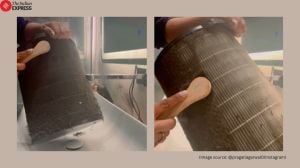Stay updated with the latest - Click here to follow us on Instagram
Punjabs history came in way of GI pleas
Punjab's history has been a major roadblock in its run for geographical indication.
Punjab’suous history has been a major roadblock in its run for geographical indication (GI). Due to invasions by foreign rulers,Partition of the country and then reorganisation,Punjabs traditions and art forms are a common legacy of other states and countries.
After the GI of Goods (Registration and Protection) Act 1999 was enacted,all states were asked to identify products from their regions that could be protected. The Patent Information Centre (PIC) of the Punjab State Council for Science and Technology (PSCST) identified Phulkari,inlay work done on furniture in Hoshiarpur,dhoda (a sweetmeat) made in Kotkapura and handmade strings of Patiala. While Hoshiarpur inlay workers did not evince interest in getting their art protected,it turned out that the other goods were made in Haryana and Pakistan,too.
Punjab recently got GI for Phulkari after five years of legal battle.
Head of Punjab PIC Dr Neelima Jerath says: Invaders had not only influenced the art and tradition of Punjab,but also taken a leaf out of it. This diluted the originality of our states traditional art forms and food. Besides,due to Partition of the country,both Punjabs share the legacy.
The division of heritage did not end with Partition. After Independence,the states were reorganised,due to which some of our art forms,such as Phulkari,are practised in Haryana,too, she adds.
When GI for other products was ruled out,PIC started pursuing the case for Phulkari in 2005. The path was paved with hurdles as the embroidered art was practised in West Punjab (Pakistan),too. We conducted a study to find out differences between the art in the two countries, says Jerath.
According to the study,the base cloth used in West Punjab is comparatively finer than the east. Black or blue is not preferred for the base cloth in West Punjab,while white is not used in East Punjab. In Pakistan,fine quality silk thread is used and workmanship is more delicate,besides motifs and patterns are geometrical. On the Indian side,the patterns are more creative.
Only silk thread is used for embroidery in West Punjab,but use of cotton and woollen thread is prevalent on the eastern side,where types of stitches are also more. Two or three bands of cloth are first embroidered and then joined together in West Punjab whereas the sequence is vice versa on the Indian side.
Within the country,however,there is not much difference between the art form in Haryana and Punjab,though the ones made in Hisar and Hansi have small round pieces of mirrors woven in. Hisar also has a distinction in weaving woollen Phulkari.
In Punjab,Phulkari work is done all over the state,but the best ones come from Bathinda and its nearby areas,and are known as sainchis.
The origin of Phulkari is not clearly known,but it could be traced to 15th Century,as it finds a mention in the Guru Granth Sahib. The first official record of Phulkari is that by FA Steel in 1888 in the Journal of Indian Art,says the PIC study.







